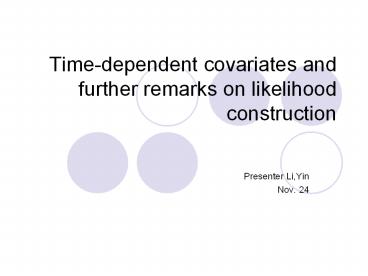Time-dependent%20covariates%20and%20further%20remarks%20on%20likelihood%20construction - PowerPoint PPT Presentation
Title:
Time-dependent%20covariates%20and%20further%20remarks%20on%20likelihood%20construction
Description:
Time-dependent covariates and further remarks on likelihood construction Presenter Li,Yin Nov. 24 – PowerPoint PPT presentation
Number of Views:87
Avg rating:3.0/5.0
Title: Time-dependent%20covariates%20and%20further%20remarks%20on%20likelihood%20construction
1
Time-dependent covariates and further remarks on
likelihood construction
- Presenter Li,Yin
- Nov. 24
2
Tests of proportionality for cox regrssion
- 1 Kaplan-Meier curves
- Works best for time fixed covariates
with few levels. - 2 Including time dependent covariates in the cox
model - 3 Tests and graphs based on the Schoenfeld
residuals
3
Data set for example
- The goal of the UIS data is to model time until
return to drug use . - The patients were randomly assigned to two
different sites (site0 is site A and site1 is
site B). - Herco indicates heroine or cocaine use in the
past three months (herco1 indicates heroine and
cocaine use, herco2 indicates either heroine or
cocaine use and herco3 indicates neither heroine
nor cocaine use). - ndrugtx indicates the number of previous drug
treatments.
4
Cox regression model for uis_small
5
Kaplan-Meier curves
- It is very easy to create the graphs in SAS using
proc lifetest. The plot option in the model
statement lets you specify both the survival
function versus time as well as the
log(-log(survival) versus log(time).
6
Tests and graphs based on the Schoenfeld
residuals
- Testing the time dependent covariates is
equivalent to testing for a non-zero slope in a
generalized linear regression of the scaled
Schoenfeld residuals on functions of time. A
non-zero slope is an indication of a violation of
the proportional hazard assumption.
7
Including time dependent covariates in the cox
model
- Generate the time dependent covariates by
creating interactions of the predictors and a
function of survival time and include in the
model. If any of the time dependent covariates
are significant then those predictors are not
proportional.
proc phreg datauis model timecensor(0) age race treat site agesite aget racet treatt sitet aget agelog(time) racet racelog(time) treatt treatlog(time) sitet sitelog(time) proportionality_test test aget, racet, treat, sitet run
8
Including time dependent covariates in the cox
model (continued)
9
When the proportional hazard assumption is
violated
- If one of the predictors was not proportional
there are various solutions to consider. - We can change from using a semi-parametric Cox
regression model to using a parametric regression
model. - Another solution is to include the time-dependent
variable for the non-proportional predictors. - Finally, we can use a model where we stratify on
the non-proportional predictors.
10
Two types of time dependent covariates
- External
- Internal
- A covariate that is not external is called
internal. - Internal covariates typically arise as
time-dependent measurements taken on an
individual study subject, the path of which is
affected by the survival status.
11
Examples
- External covariates
- 1st type fixed or time independent covariates
- 2nd type defined covariates
- eg. Stress factors under control of
the experimenter that is to be varied
in a predetermined way - eg. Age of an individual in a trial of
long duration - 3rd type ancillary covariates
- eg. Measures of pollutions as a
predictor for the frequency of asthma attacks.
12
Examples
- Internal covariates
- Eg. Measures of a patients general condition
take values of 0,1,2,3,4. 0 is assigned to z(t)
for dead and 4 is for no disease and 1,2,3
represent levels of decreasing disability. - Eg. Measures of immune status such as white
blood count as a predictor for examining the
effect of immunotherapy on the failure rate in
cancer.
13
Likelihood construction
- Problem setup
- n individuals start on test at t0
- The risk of failure at time t
- where x is a vector of fixed basic
covariates measured in advance and theta is a
vector of parameters. - The data for the ith individual are
14
- Under random censoring
15
- For any tgt0, let the history be
Then, the likelihood can be constructed as a
product of the conditional terms.
16
- Let be the set of
labels associated with the individuals failing in
,and is the set of labels
associated with the individuals censored in
.
17
(No Transcript)
18
- The first factor on the right side arises from
the failure information
- The remaining factor arises from the censoring
information
- If this term depends on the , the
censoring mechanism is said to be informative,
and otherwise noninformative.
19
Likelihood construction for internal covariates
- The probability contribution of the interval
is written as
Where
has failure, censoring and
covariates information up to time t and
has only the covariates
information.

